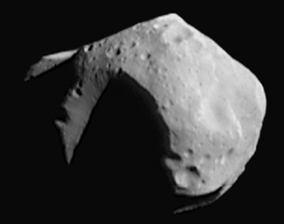
Back ماتيلد 253 Arabic 253 Mathilde (كويكب) ARZ (253) Mathilde Catalan (253) Матильда CE (253) Mathilde German 253 Ματθίλδη Greek 253 Mathilde Esperanto (253) Mathilde Spanish 253 Matilde Basque ۲۵۳ ماتیلده Persian
 253 Mathilde as seen by NEAR in 1997 | |
| Discovery[1] | |
|---|---|
| Discovered by | J. Palisa |
| Discovery site | Vienna Obs. |
| Discovery date | 12 November 1885 |
| Designations | |
| (253) Mathilde | |
| Pronunciation | /məˈtɪldə/ |
Named after | Mathilde Loewy |
| A885 VA, 1915 TN 1949 OL1 | |
| Main belt | |
| Orbital characteristics[2] | |
| Epoch 31 July 2016 (JD 2457600.5) | |
| Uncertainty parameter 0 | |
| Observation arc | 130.38 yr (47622 d) |
| Aphelion | 3.35003411 AU (501.157970 Gm) |
| Perihelion | 1.9467702 AU (291.23268 Gm) |
| 2.648402147 AU (396.1953219 Gm) | |
| Eccentricity | 0.26492652 |
| 4.31 yr (1574.3 d) | |
Average orbital speed | 17.98 km/s[3] |
| 170.584348° | |
| 0° 13m 43.248s / day | |
| Inclination | 6.7427122° |
| 179.58936° | |
| 157.39642° | |
| Earth MOID | 0.939032 AU (140.4772 Gm) |
| Jupiter MOID | 2.06073 AU (308.281 Gm) |
| TJupiter | 3.331 |
| Physical characteristics | |
| Dimensions | 52.8 km[2] (66×48×46 km[4]) |
| Mass | (1.033±0.044)×1017 kg[5] |
Mean density | 1.3 g/cm3[5] |
Equatorial surface gravity | 0.00989 m/s2 |
Equatorial escape velocity | 22.9 m/s |
| 417.7 h (17.40 d)[2] 17.406 ± 0.010 d[6] (17 d 9 h 45 min) | |
| 0.0436±0.004[2] | |
| Temperature | ≈ 174[7] K |
| Cb[2] | |
| 10.3[2] | |
253 Mathilde is an asteroid in the intermediate asteroid belt, approximately 50 kilometers in diameter, that was discovered by Austrian astronomer Johann Palisa at Vienna Observatory on 12 November 1885. It has a relatively elliptical orbit that requires more than four years to circle the Sun. This tumbling asteroid has an unusually slow rate of rotation, requiring 17.4 days to complete a 360° revolution about its axis. It is a primitive C-type asteroid, which means the surface has a high proportion of carbon; giving it a dark surface that reflects only 4% of the light that falls on it.[8]
Mathilde was visited by the NEAR Shoemaker spacecraft during June 1997, on its way to asteroid 433 Eros. During the little flyby, the spacecraft imaged a hemisphere of the asteroid, revealing many large craters that had gouged out depressions in the surface. It was the first carbonaceous asteroid to be explored and, until 21 Lutetia was visited in 2010, it was the largest asteroid to be visited by a spacecraft.
- ^ Cite error: The named reference
moorewas invoked but never defined (see the help page). - ^ a b c d e f Unless otherwise noted, parameters are per: Yeomans, Donald K. (29 August 2003). "253 Mathilde". JPL Small-Body Database Browser. NASA. Retrieved 12 May 2016.
- ^ For semi-major axis a, orbital period T and eccentricity e, the average orbital speed is given by:
- ^ Cite error: The named reference
icarus140was invoked but never defined (see the help page). - ^ a b Cite error: The named reference
Yeomans 1997was invoked but never defined (see the help page). - ^ Stefano Mottola; et al. (1995). "The slow rotation of 253 Mathilde". Planetary and Space Science. 43 (12): 1609–1613. Bibcode:1995P&SS...43.1609M. doi:10.1016/0032-0633(95)00127-1.
- ^ For asteroid albedo α, semimajor axis a, solar luminosity , Stefan–Boltzmann constant σ and the asteroid's infrared emissivity ε (≈ 0.9), the approximate mean temperature T is given by:
- ^ Cite error: The named reference
flybywas invoked but never defined (see the help page).
![{\displaystyle {\begin{aligned}v_{o}&={\frac {2\pi a}{T}}\left[1-{\frac {e^{2}}{4}}-{\frac {3e^{4}}{64}}-\dots \right]\\&=18.31\ {\mbox{km/s}}\left[1-0.0177-0.00008-\cdots \right]\\&\approx 17.98\ {\mbox{km/s}}\\\end{aligned}}\!\,}](https://wikimedia.org/api/rest_v1/media/math/render/svg/53d01a9aa752b2d7640a8be18cd4abb402ed8e2c)

